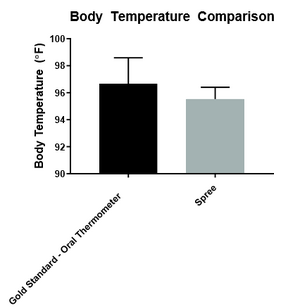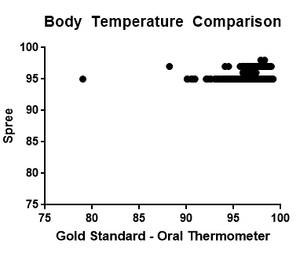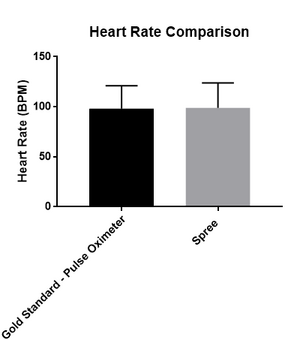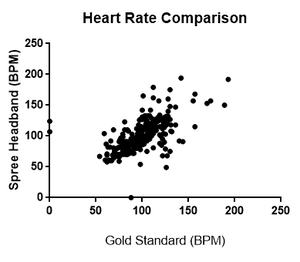BME100 f2016:Group4 W1030AM L3
| Home People Lab Write-Up 1 | Lab Write-Up 2 | Lab Write-Up 3 Lab Write-Up 4 | Lab Write-Up 5 | Lab Write-Up 6 Course Logistics For Instructors Photos Wiki Editing Help | |||||||||||||||
|
OUR TEAM
LAB 3 WRITE-UPDescriptive Stats and GraphBody Temperature Comparisons
Inferential StatsHeart Rate Correlation Coefficient (Pearson's r):0.6332 P-Value:0.4775 Body Temperature Correlation Coefficient (Pearson's r): 0.1919 P-Value: 0.0005
Design Flaws and RecommendationsIn our statistical experiment we found that the major design flaws of the Spree headbands ability in comparison to the "gold standard" arose when we studied body temperature, while the heart rate was fairly accurate but not entirely reliable. The body temperature we found to be inaccurate when we calculated the Pearson's r coefficient which was .191 and the p-value was .0005. The Pearson's r value to be considered even remotely accurate has to be decently close to one so this shows that .191 is a horrifically off from 1 which shows that there is almost no correlation between the 2 data sets we tested. The P-value is also supposed tell weather our null hypothesis is correct or not, in this experiment our null hypothesis is that the spree headband is accurate. The null hypothesis is disproved when the P-value is less than .05 and with our p-value being .0005 this disproves the accuracy of the spree headbands ability to monitor body temperature, there fore the spree headband is inaccurate in its ability to monitor body temperature. Heart rate however we did find to be somewhat accurate and reliable, when running our statistical test we found our p-value to be .4775 and the Pearson's r coefficient was .6332. The Pearson's r value is closer to 1 than it is closer to 0 so this shows that there is some correlation and accuracy to the spree headbands ability to monitor heart rate, but it is not completely reliable since the value is not 1. The accuracy of the Spree headbands ability to monitor heart rate was validated more when we found the p-value being .4775. As I stated before the null hypothesis regarding this device is that is accurate and this is disproved when the p-value is less than .005 but since our value is above that, the null hypothesis in regard to the spree headbands ability to monitor heart rate remains true. There fore the Spree headband is reliable somewhat accurate in it's ability to monitor heart rate but inaccurate when it comes to monitoring body temperature.
Experimental Design of Own DeviceWe will use our device and test at multiple times during the day and after certain activities such as physical activity, eating, sleeping etc. We will take our watch and test the subjects as well as the same subjects at the same time and use a gold standard for blood glucose measurement, the Accucheck Active. We would have a large sample size of three hundred people and random and then compare between out device and the Accucheck. We also want to test efficiency and speed of our device to do this we would take a sample size that would be random but have to consist of people with diabetes the gold standard for this would be AlphaTrak 2, the most commonly bought glucose measuring device. We would take the times of each reading and how long it takes are sample not only to get the reading but also how long it takes them to set everything up and actually test their blood. | |||||||||||||||






